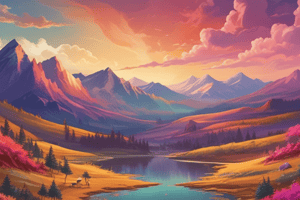Podcast
Questions and Answers
What are the three main types of color mixing mentioned in the text?
What are the three main types of color mixing mentioned in the text?
- Ink, paint, and dyes
- Red, green, and blue
- Primary, secondary, and tertiary
- Additive, subtractive, and blending (correct)
Which type of color mixing occurs with light?
Which type of color mixing occurs with light?
- Subtractive
- Blending
- Additive (correct)
- Primary
What do you need to blend together to create the color purple?
What do you need to blend together to create the color purple?
- Blue and red paint (correct)
- Yellow and cyan paint
- Green and yellow paint
- Red and green paint
In color mixing, what do you add to another substance in subtractive mixing?
In color mixing, what do you add to another substance in subtractive mixing?
What is the purpose of referring to color wheel charts when mixing colors?
What is the purpose of referring to color wheel charts when mixing colors?
Which type of colors are created by combining two or more base pigments into a harmonious blend?
Which type of colors are created by combining two or more base pigments into a harmonious blend?
Why is classification important in zoological taxonomy?
Why is classification important in zoological taxonomy?
What is the order that humans belong to in the zoological taxonomy system?
What is the order that humans belong to in the zoological taxonomy system?
Which of the following is not a factor used in classifying animals?
Which of the following is not a factor used in classifying animals?
What does the zoological taxonomy system help biologists recognize?
What does the zoological taxonomy system help biologists recognize?
How does classifying animals assist in conservation efforts?
How does classifying animals assist in conservation efforts?
What type of classification is essential for understanding which animals may pose threats to certain species?
What type of classification is essential for understanding which animals may pose threats to certain species?
Flashcards are hidden until you start studying
Study Notes
Colors play a significant role in our lives from art to fashion, interior design, and even advertising. One of the fascinating aspects of colors is their ability to be mixed together to create new shades. Color mixing involves combining two or more primary, secondary, or tertiary paint colors to make something entirely different. This process can yield remarkable results when done correctly, opening up countless opportunities for artistic expression and experimentation.
There are three main types of color mixing: additive, subtractive, and blending. Additive color mixing occurs with light, where red, green, and blue components combine to create white light or other bright colors. Subtractive mixes occur physically—by adding pigments, dyes, or paints to another substance such as ink. Blendable colors are created by combining two or more base or primary pigments into one visually harmonious blend. For example, if you want purple, you would need to blend blue and red paint together. Similarly, yellow and cyan might result in a shade of green. When trying out these combinations, it's always useful to refer back to the basic color wheel charts available online to see what your finished product may look like before making any commitments on canvas.
Color mixing also plays an important part in digital painting programs like Adobe Photoshop or CorelDRAW. In digital form, colors work slightly differently because they exist digitally rather than being physical representations. However, both have similar processes involved; after all, whether working on paper or pixels, there's only so many ways you can effectively mix colors! Whether you're crafting a magical landscape or just looking to spruce up your home décor, understanding how various colors interact allows artists to take advantage of this science in unique and creative ways.
Studying That Suits You
Use AI to generate personalized quizzes and flashcards to suit your learning preferences.




